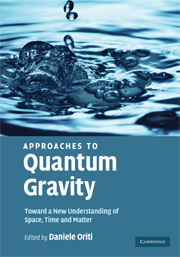Book contents
- Frontmatter
- Contents
- List of contributors
- Preface
- Part I Fundamental ideas and general formalisms
- 1 Unfinished revolution
- 2 The fundamental nature of space and time
- 3 Does locality fail at intermediate length scales?
- 4 Prolegomena to any future Quantum Gravity
- 5 Spacetime symmetries in histories canonical gravity
- 6 Categorical geometry and the mathematical foundations of Quantum Gravity
- 7 Emergent relativity
- 8 Asymptotic safety
- 9 New directions in background independent Quantum Gravity
- Questions and answers
- Part II String/M-theory
- Part III Loop quantum gravity and spin foam models
- Part IV Discrete Quantum Gravity
- Part V Effective models and Quantum Gravity phenomenology
- Index
1 - Unfinished revolution
from Part I - Fundamental ideas and general formalisms
Published online by Cambridge University Press: 26 October 2009
- Frontmatter
- Contents
- List of contributors
- Preface
- Part I Fundamental ideas and general formalisms
- 1 Unfinished revolution
- 2 The fundamental nature of space and time
- 3 Does locality fail at intermediate length scales?
- 4 Prolegomena to any future Quantum Gravity
- 5 Spacetime symmetries in histories canonical gravity
- 6 Categorical geometry and the mathematical foundations of Quantum Gravity
- 7 Emergent relativity
- 8 Asymptotic safety
- 9 New directions in background independent Quantum Gravity
- Questions and answers
- Part II String/M-theory
- Part III Loop quantum gravity and spin foam models
- Part IV Discrete Quantum Gravity
- Part V Effective models and Quantum Gravity phenomenology
- Index
Summary
One hundred and forty-four years elapsed between the publication of Copernicus's De Revolutionibus, which opened the great scientific revolution of the seventeenth century, and the publication of Newton's Principia, the final synthesis that brought that revolution to a spectacularly successful end. During those 144 years, the basic grammar for understanding the physical world changed and the old picture of reality was reshaped in depth.
At the beginning of the twentieth century, General Relativity (GR) and Quantum Mechanics (QM) once again began reshaping our basic understanding of space and time and, respectively, matter, energy and causality – arguably to a no lesser extent. But we have not been able to combine these new insights into a novel coherent synthesis, yet. The twentieth-century scientific revolution opened by GR and QM is therefore still wide open. We are in the middle of an unfinished scientific revolution. Quantum Gravity is the tentative name we give to the “synthesis to be found”.
In fact, our present understanding of the physical world at the fundamental level is in a state of great confusion. The present knowledge of the elementary dynamical laws of physics is given by the application of QM to fields, namely Quantum Field Theory (QFT), by the particle-physics Standard Model (SM), and by GR.
- Type
- Chapter
- Information
- Approaches to Quantum GravityToward a New Understanding of Space, Time and Matter, pp. 3 - 12Publisher: Cambridge University PressPrint publication year: 2009
- 2
- Cited by

